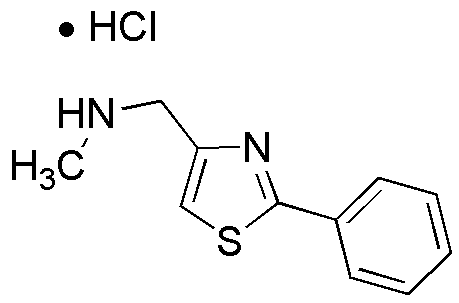Methyl-(2-phenyl-thiazol-4-ylmethyl)amine·HCl is widely utilized in research focused on:
- Pharmaceutical Development: This compound serves as a key intermediate in the synthesis of various pharmaceuticals, particularly in developing drugs targeting neurological disorders.
- Biochemical Research: It is used in studies investigating enzyme inhibition and receptor binding, helping researchers understand disease mechanisms and drug interactions.
- Material Science: The compound can be incorporated into polymers to enhance their properties, such as thermal stability and mechanical strength, making it valuable in the production of advanced materials.
- Agricultural Chemistry: It is explored for its potential as a pesticide or herbicide, contributing to the development of safer and more effective agricultural products.
- Analytical Chemistry: This chemical is utilized in various analytical techniques, including chromatography, to separate and identify complex mixtures, aiding in quality control processes.
General Information
Properties
Safety and Regulations
Applications
Methyl-(2-phenyl-thiazol-4-ylmethyl)amine·HCl is widely utilized in research focused on:
- Pharmaceutical Development: This compound serves as a key intermediate in the synthesis of various pharmaceuticals, particularly in developing drugs targeting neurological disorders.
- Biochemical Research: It is used in studies investigating enzyme inhibition and receptor binding, helping researchers understand disease mechanisms and drug interactions.
- Material Science: The compound can be incorporated into polymers to enhance their properties, such as thermal stability and mechanical strength, making it valuable in the production of advanced materials.
- Agricultural Chemistry: It is explored for its potential as a pesticide or herbicide, contributing to the development of safer and more effective agricultural products.
- Analytical Chemistry: This chemical is utilized in various analytical techniques, including chromatography, to separate and identify complex mixtures, aiding in quality control processes.
Documents
Safety Data Sheets (SDS)
The SDS provides comprehensive safety information on handling, storage, and disposal of the product.
Product Specification (PS)
The PS provides a comprehensive breakdown of the product’s properties, including chemical composition, physical state, purity, and storage requirements. It also details acceptable quality ranges and the product's intended applications.
Certificates of Analysis (COA)
Search for Certificates of Analysis (COA) by entering the products Lot Number. Lot and Batch Numbers can be found on a product’s label following the words ‘Lot’ or ‘Batch’.
*Catalog Number
*Lot Number
Certificates Of Origin (COO)
This COO confirms the country where the product was manufactured, and also details the materials and components used in it and whether it is derived from natural, synthetic, or other specific sources. This certificate may be required for customs, trade, and regulatory compliance.
*Catalog Number
*Lot Number
Safety Data Sheets (SDS)
The SDS provides comprehensive safety information on handling, storage, and disposal of the product.
DownloadProduct Specification (PS)
The PS provides a comprehensive breakdown of the product’s properties, including chemical composition, physical state, purity, and storage requirements. It also details acceptable quality ranges and the product's intended applications.
DownloadCertificates of Analysis (COA)
Search for Certificates of Analysis (COA) by entering the products Lot Number. Lot and Batch Numbers can be found on a product’s label following the words ‘Lot’ or ‘Batch’.
*Catalog Number
*Lot Number
Certificates Of Origin (COO)
This COO confirms the country where the product was manufactured, and also details the materials and components used in it and whether it is derived from natural, synthetic, or other specific sources. This certificate may be required for customs, trade, and regulatory compliance.


